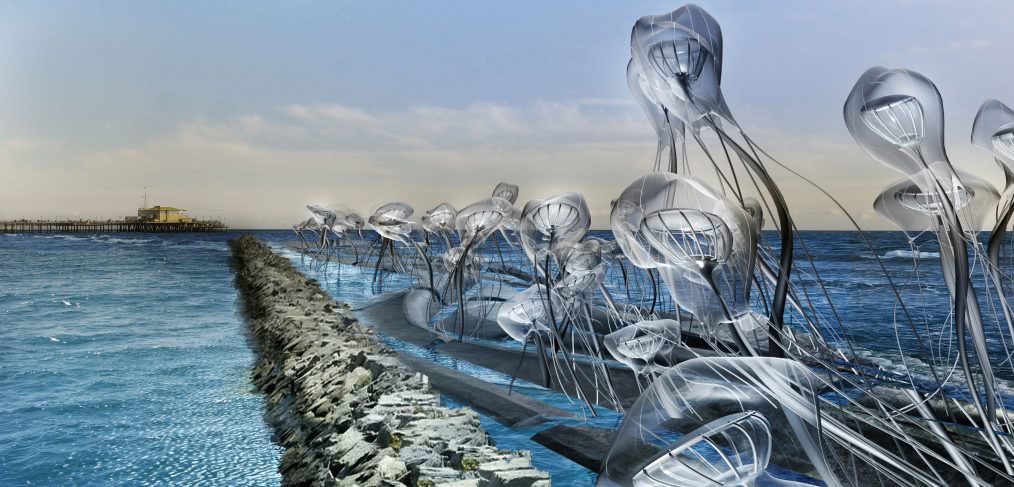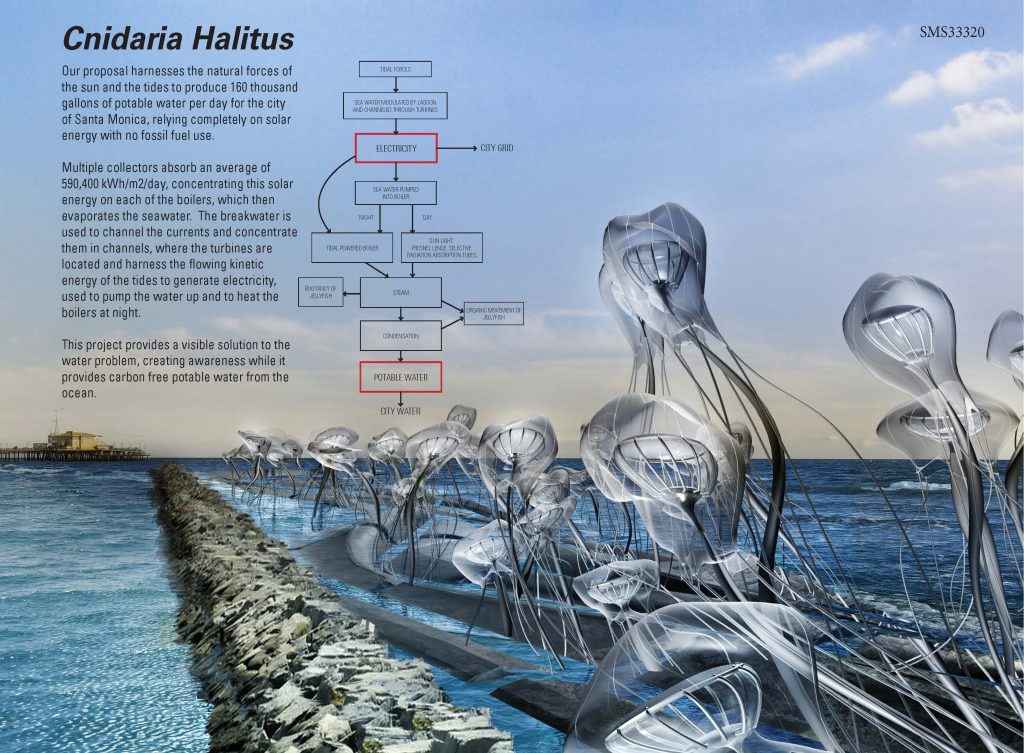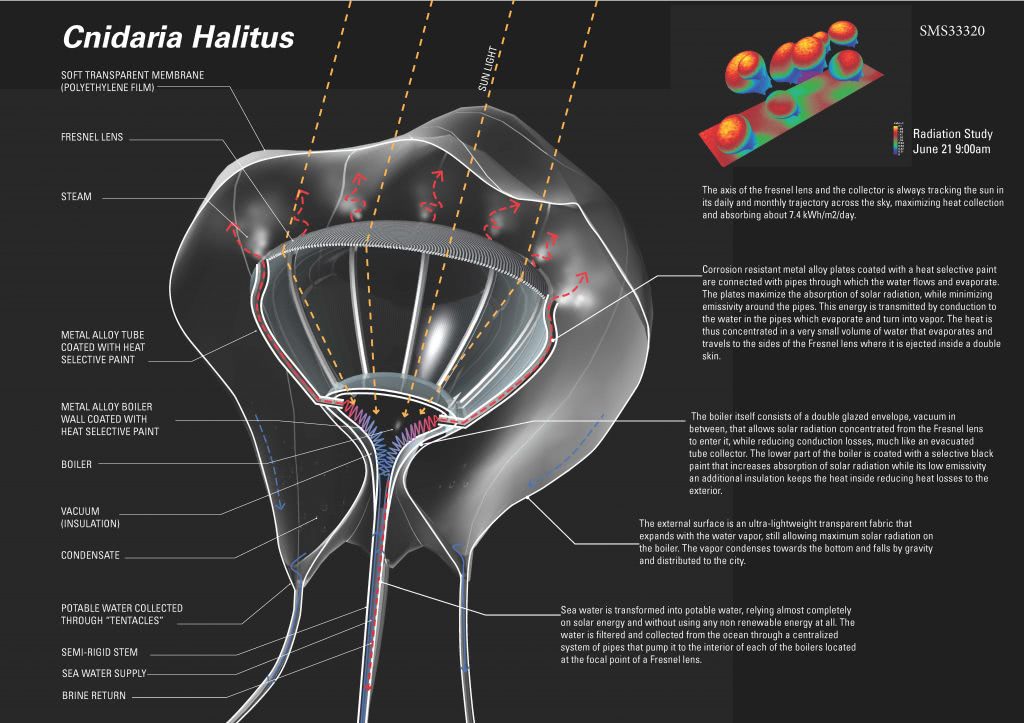
Cnidaria Halitus: Harnessing the Sun and Tides for Potable Water

CRTKL’s Pablo La Roche, John Eric Chung, Danxi Zou, Jingyan Zhang and Tianyi Deng discuss their latest green innovation and explain how it can produce potable water for California.
With climate change becoming more dramatic and California’s drought continuing to worsen, I often find myself asking: How can I use design to mitigate the effects of climate change and benefit the community? The answer isn’t always simple, but with dedication and a hardworking team, there are answers.
The Land Art Generator Initiative (LAGI) organizes a biennial competition in different cities of the world—this year, Santa Monica. The goal is to design a site-specific public artwork that, in addition to its conceptual beauty, has the ability to harness energy cleanly from nature and convert it into electricity and/or drinking water for the city.
Our team developed Cnidaria Halitus—jellyfish-shaped technology that harnesses the natural forces of the sun and the tides to produce 160 thousand gallons of potable water per day for the city of Santa Monica.
 LAGI selected a site for the conceptual project that is in the area around a breakwater located off the Santa Monica Piers; in simpler terms, the space is basically a piece of the ocean. We immediately decided to create something that would respect and reflect the water while also using that water to produce something beneficial for the community.
LAGI selected a site for the conceptual project that is in the area around a breakwater located off the Santa Monica Piers; in simpler terms, the space is basically a piece of the ocean. We immediately decided to create something that would respect and reflect the water while also using that water to produce something beneficial for the community.
So, we thought, what if we create an “air organism” that breathes and produces potable water?
We even gave our organism a pseudo-scientific name: Cnidaria Halitus, which roughly means breathing jellyfish. The main skin of our jellyfish technology is similar to scientific balloons made from polyethylene—the same type of material used for plastic bags. This membrane will float in the air to imitate the motion of jellyfish.
Creating beautiful artwork was easy enough. The real challenge, of course, was producing something that harnesses clean energy.
Relying completely on solar and tidal energy, the Cnidaria Halitus transforms seawater into potable water, all without using non-renewable energy.
The process begins in the ocean. The breakwater is used to channel currents into slits at the base where the turbines are located. This harnesses kinetic energy of the tides to generate electricity. The electricity is then used to pump the water up to small boilers, located inside the jellyfish, and to aid with the evaporation process during the night.
Inside the jellyfish is a flat lens called a Fresnel lens. The axis of the Fresnel lens tracks the sun in its daily trajectory across the sky, maximizing heat collection and absorbing about 7.4 kWh/m2 per day.
 The boiler itself consists of a double glazed envelope that allows solar radiation concentrated from the Fresnel lens to enter, while reducing conduction losses—much like an evacuated tube collector found in domestic solar heaters. All of the energy absorbed inside the evaporation chamber is transmitted by conduction to the water flowing inside the pipes, concentrating it in a very small volume of water which then evaporates and travels to the sides of the Fresnel lens where it is ejected as vapor inside the polyethylene membrane.
The boiler itself consists of a double glazed envelope that allows solar radiation concentrated from the Fresnel lens to enter, while reducing conduction losses—much like an evacuated tube collector found in domestic solar heaters. All of the energy absorbed inside the evaporation chamber is transmitted by conduction to the water flowing inside the pipes, concentrating it in a very small volume of water which then evaporates and travels to the sides of the Fresnel lens where it is ejected as vapor inside the polyethylene membrane.
The vapor condenses on the cooler inner surface of the polyethylene membrane and falls, thanks to gravity, into collectors. Each of these distillers can evaporate about 4000 gallons of water per day. Supported by a semi-rigid stem, the jellyfish will rise and fall organically due to the change in buoyancy from the steam-condensation cycle, as if they are alive.
The forty Cnidaria Halitus we proposed will generate an average of 160 thousand gallons of water per day, or about 2% of the potable water consumption in the city of Santa Monica.
This project provides a visible solution to California’s water problem, creating awareness while providing carbon-free potable water from the ocean. In order to combat climate change, we have to continue to look for innovative, green solutions that not only improve quality of life, but that respect and honor the environment.
